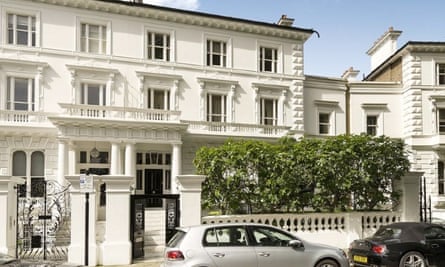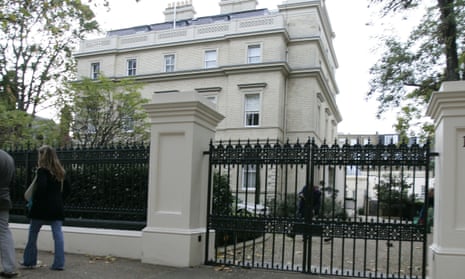Some of Britain’s wealthiest homeowners have seen as much as £13m wiped off the value of their property in a year as Brexit uncertainty and tax changes continue to wreak havoc in the prime central London market.
According to new research, Kensington Palace Gardens in west London tops the list of the most expensive streets in Britain, with an average property value of £35.7m – although that is £2.5m less than this time last year, when the figure was £38.3m. In July 2015 a typical property in the street was worth £42.6m – which reflects a near-£7m decline in just over two years, said property website Zoopla in its annual Rich List of house prices.
Kensington Palace Gardens is reported to be home to Chelsea football club’s owner, Roman Abramovich, the Formula One heiress Tamara Ecclestone and the Sultan of Brunei, Hassanal Bolkiah.
However, the ultra-wealthy owners of homes in the Boltons, two miles south, have had a much tougher time of it. Zoopla said the average value of a property on the street in South Kensington had plummeted from £33.3m this time last year to just under £20m now. Previous residents of the Boltons include Madonna and actor Douglas Fairbanks Jr. The Boltons came third in the table of the top 10 most expensive streets, all of which are in London.

Other roads in the area, such as Manresa Road in Chelsea, had smaller falls, and a few increased in value over the year.
Other surveys have also reported sharp falls in some of the capital’s most expensive boroughs. Last month the property site Rightmove said the average asking price of a newly marketed home in Kensington and Chelsea fell by £308,000 between August and September. On Tuesday, upmarket estate agent Savills said prices in central London had fallen by 3.2% in the first nine months of this year, and were 15.2% below their peak three years ago.
On Friday, Nationwide said London house prices had fallen for the first time year on year since the height of the financial crisis eight years ago.
Rightmove described the slump in the high-end central London market as a “readjustment”, and quoted an estate agent saying that, since the introduction of the 3% surcharge on stamp duty paid by investors, along with the uncertainty over how Brexit would pan out, “investors have been standing on the sidelines”.
Zoopla said there were now 14,417 streets in Britain where the average property value is £1m or more – up from 12,418 in 2016. Of those, 5,899 are in Greater London. The Yorkshire and the Humber region has 77 £1m streets, north-east England has 45 and Wales has 11.
In line with this trend, 19 of the 20 towns with the highest number of £1m-plus streets are in southern England. Guildford in Surrey takes the top spot with 204, with Reading in Berkshire in second place with 187.
Zoopla says its website attracts more than 40m visits per month. Asked about the large fall recorded for the Boltons, a spokesman said: “The number of estimates on a given road can vary and can be subject to change throughout the year. In the case of the Boltons, it could be that several estimates have been newly added to listings which previously didn’t have a figure attached, and this may have had the knock-on impact on the street’s average value compared to last year.”

Comments (…)
Sign in or create your Guardian account to join the discussion